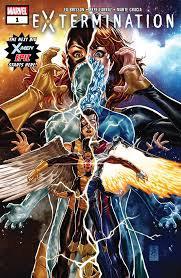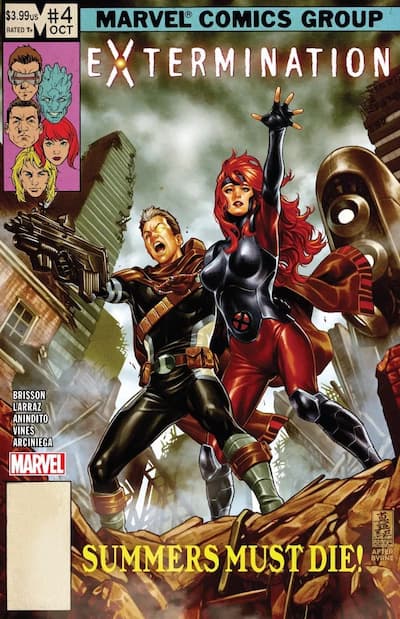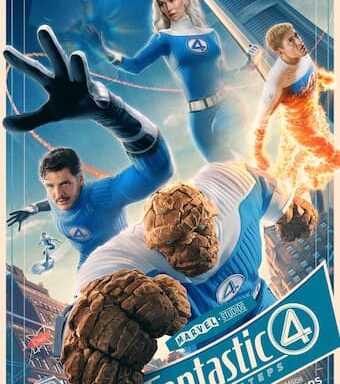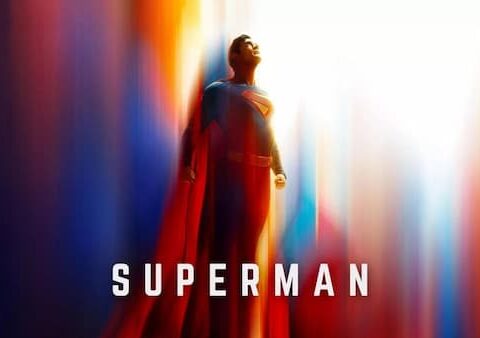So, a series of very big event stories happening in the X-Men world: and Extermination came packaged as a pretty big deal.
From the outset, we’re warned that this event marks the final handling of the time-displaced teen-bopper X-Men (the original X-Men brought from the past by Hank McCoy so long ago).
This is, seemingly, where their story ends. So this is big stuff.
My feeling about that are a mixed bag: reflecting the fact that my feelings about the time-displaced X-Men have been a mixed bag in general. I loved the original stories (which feel like so long ago now), in which McCoy took it upon himself to pluck these kids from the sixties and bring them forward to the present day.
I think there were at least two or three years of really good material, really good storytelling, that came from that.
The last few years, however, have been a different matter. In my opinion, the X-Men kids’ saga ran out of steam quite a while back, and they’ve kind of been hanging around like an awkward and uncertain presence in the contemporary X-Men landscape.
The last few monthly titles centered on these characters have been poor: they’ve become the x-books that I skip consistently, even the more recent X-Men: Blue (reviewed here).
So it probably is time for those characters to be separated from the current scene.
The question is how: and what will it all mean?
In Extermination #1, Ed Brisson starts to tell us.
What’s so good about Extermination #1 is the pace of the storytelling. Mystery and intrigue builds slowly, events unfold and questions arise – with no immediate answers. What we get is characters reacting to bad events, while we – the audience – try to work out what’s going on.
Scott and Bloodstorm are randomly attacked: Bloodstorm is killed. Iceman is attacked and goes missing. Cable suddenly appears, trying to rescue Bobby. Then Cable is suddenly and unceremoniously killed by an unknown, hooded figure. Rachel Grey realises that Bloodstorm’s killer was ‘Ahab’, a terrible figure from her tortured past/future. But they discover that the person who killed Cable wasn’t the same person who killed Bloodstorm.
And so, all of this stuff happens, but it’s all mystery at this point. This is really good storytelling. And you sense easily that this is going to build to a really epic, substantial piece of X-Men mythology.
Character work is spot-on too. Rachel gets good page-time (always a good thing): and Jean (older Jean) showing up with Nightcrawler to mourn her dead son is one of the potent moments of the book.
Pepe Larraz‘s art and Marte Gracia‘s colors are spectacularly good: this is a great visual experience, befitting a story of this magnitude.
Extermination #2 is even better. It looks stunning and it feels, every step of the way, like you’re in the midst of a growing X-Men classic. We’re drip-fed half-answers as the book goes on: but what’s great is that none of this is done through exposition or narrative tricks, but entirely through real-time events and the characters’ reaction. What we learn we learn at the same time as the characters do.
A young Cable appears to be behind the attacks: although the confusion is still ongoing, because ‘Ahab, the Master Hound’ is also trying to capture or eliminate each of the young, time-displaced X-Men. There are two attacks on the mansion; one by the young Cable and one by Ahab – at present, they seem unconnected, though both are focused firmly on the time-displaced kids.
Angel is lost to ‘Cable’, the situation seems to get worse with each page – and we still have more questions than answers.
What’s absolutely perfect about Extermination #2 is, again, the characters.

Firstly, the mix of characters here is rich and really hammers home that this is an X-Men family event in the best tradition: not just the principle characters you’d expect, but the likes of Domino, Shatterstar, Boomer, Warpath, etc. And they’re all brought into the story so that this really feels like one of those old x-books from my adolescence.
The early scene in Kitty’s office exemplifies this: we see this array of familiar characters (some of which I haven’t actually seen for a long while), all gathered to discuss the crisis. The ‘lighting’, so to speak, in this scene is beautiful – perfectly evoking the solemn mood.
At the micro level, there’s such good character work here too, all of which fits perfectly: the young Jean, young Scott scene early on, for example, or the scene between the two Hank McCoys, or seeing young Jean flip into angry, bad-ass mode when Angel and Hank are attacked. These little things really make a story like this. Add to that also one of my favorite moments of the book: Rachel going into a desperate rage against Ahab.
This is all superb, superb stuff.
Extermination #3 sees the losses mount and the tension rise. The remaining time-displaced X-Men kids are split up and placed under the protection of different groups: young Cyclops in Searebro with the older Jean Grey’s team, the kid Jean Grey (Marvel Girl) with Domino and X-Force, and the younger Hank McCoy at the mansion. The younger McCoy is taken by Ahab, however – Beast, Logan and the others can’t protect him.
Ahab – via his two mutant child prodigies, ‘Maxine’ and ‘Manon’ – also manages to hack into the minds of key X-Men at key points to use them as his tools: Logan at the mansion, Nightcrawler with Jean’s team, and Shatterstar aboard the jet. Each of these tries to attack the respective x-kids at these different locations.
There’s a lot to keep track of here, but the tension is palpable throughout. It’s also clear that Ahab and his cohorts have no idea where the young Cable came from or what he’s up to.
For me, the best parts of this book are the scenes with Domino and X-Force aboard the jet. It’s just a thrill to see the kid Jean Grey (my favorite of the five time-displaced X-Men kids) hooking up with the classic, original X-Force. Boomer gets some fun dialogue in (of course), but it’s the Domino/Jean conversation that’s most interesting, as Domino makes it clear X-Force are not like the X-Men: they intend to find and kill whoever was responsible for Cable’s murder.
It’s a great bit of writing, in fact, that Little Jean opted to go with Domino and co (it was very much her choice, if you check Extermination #2: Kitty wanted her with her older namesake at Searebro, but Little Jean insisted on going with X-Force). Here, we learn why – because Little Jean read Domino and the others’ minds and knows they mean business, so she wanted to be with them. I really love that detail.
My quibble here is that we seem to have lost track of Rachel Grey at this point: which is odd, as she was so key in the previous issues.
In Extermination #4, we finally get some answers. When Little Jean (Marvel Girl) and X-Force reach Young Cable, they discover what this version of Nathan is trying to do. It turns out, he killed his older self because his older had been unwilling to protect the timeline by insisting on the time-displaced X-kids being sent back to their proper era.
Young Nathan explains how Jean and the others remaining in the present is going to have a negative effect on the past, the longer they remain outside of their proper era: and that the altering of the past is going to create alternate timelines with bleak futures.
His attempts to capture the kids has been so he can send them back to their era. However, Ahab is trying to eliminate the kids (or even just one of them) entirely, because doing so in the present will alter the past and thus create a different future (one without X-Men).
I think that’s about the gist of it. I think.
It’s a bit complicated, yeah: but it kind of makes sense. And it’s pretty interesting as a thought exercise. It also ties everything back nicely to the whole story of where this all started: with Hank McCoy’s dubious decision to bring the kids forward in time – which was a morally questionable act in the first place. Now, years later, we’re seeing some of why it was such a questionable decision.
Ahab gets his pound of flesh in the end – by killing Cyclops. Yep, it’s another Death of Cyclops (!). That guy seems to die a lot. This time, it’s the kid Cyclops, however: and, actually, as the following installment reveals, it’s not Cyclops at all but Mimic, who is impersonating Scott.
All of this stuff is great: the storytelling, the suspense and tension, the characters, the ideas and themes. This is also a great Jean (Marvel Girl) book too: any time I get to see Little Jean losing her patience and going all big-time-power on everyone is a good day.

Everything builds to its conclusion in Extermination #5.
And I have to say that, although this conclusion has been somewhat choregraphed clearly in advance, Extermination #5 hits the exact right notes it needs to to bring an end to this several-year saga of the time-displaced X-Men.
It’s about halfway through the action when young Jean decides she agrees with Kid Cable’s perspective: that she and the others have to go back to their own time and that this is the only way to fix the present.
She convinces the others of this, and Kid Cable takes them back first to a few years earlier, where Kid Jean can speak to the younger versions of Ahab’s minions, Maxine and Manon (who are at the x- mansion). From them she learns how to neutralise their older selves in the battle that is occuring in the future (our present).
Later, we see that what Kid Jean learnt from the kids has automatically registered with the adult Jean Grey in the ‘present’ battle, as she has inherited the younger self’s memories.
It’s kind of neat: I like it.
The real nostalgia moment is Kid Jean and the rest of the kids arriving back at the precise moment, in the precise same room, as we saw them in way back when Hank McCoy originally came from the future to get them. This was actually the perfect way to end this, by going full circle: as soon as I saw the room and the details, I immediately flashed back to that book from years ago (and wanted to go read it again).
Jean will psychically wiped all of their memories of their time in the future – though she says they will retain the substance of those experience in some ‘unconscious’ form.
Really, this is a great moment and a sweet one. And it demonstrates the value of loyally following these sagas over many years, so that you can really feel the full scope and weight of stories like this one.
This book surprised me by getting so much else right too. The later scene of the adult Hank, Jean, Bobby and Warren (in our present) eating together at a diner is also a really perfect, sweet bit of storytelling that I wasn’t really expecting.
It was also spot-on to have each of the Kid X-Men saying a quick goodbye to their grown-up counterparts once the decision had been made to go back to their own time. This happens in the midst of battle, so these are quick moments: but the two Bobbys’ farewell was particularly sweet.
With all seemingly dealt with – the kids are back in the past, Ahab has been defeated, Maxine and Manon neutralised – there’s one last ‘shock’ twist for us at the end of the book. When we see Kid Cable going back to his hideout, we are shown who he has been secretly working with this whole time: it’s Cyclops. Seemingly THE legit Scott Summers Cyclops.
But that’s a story for elsewhere.
Extermination #5 is a fitting, effective conclusion to this storyline: and Extermination #1 – 5 in its totality is a more-than-fitting conclusion saga to this entire time-displaced X-Men saga that has been with us for several years.
I don’t think a much better or more endearing story could’ve been told. It’s a suitable last hurrah for these characters, and it’s a nice little piece of the X-Men saga that we’ve been treated to here. Stellar work, all around.




